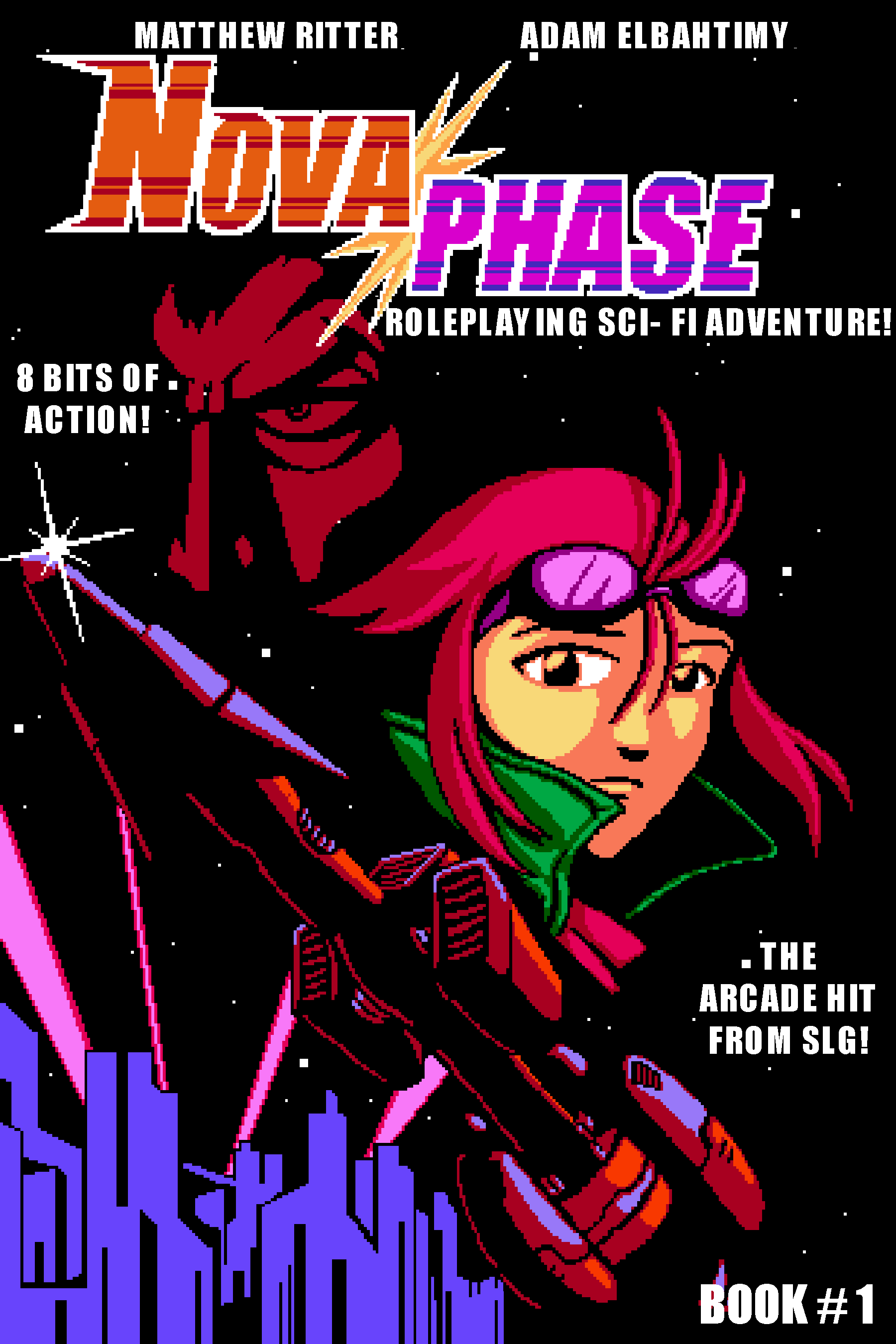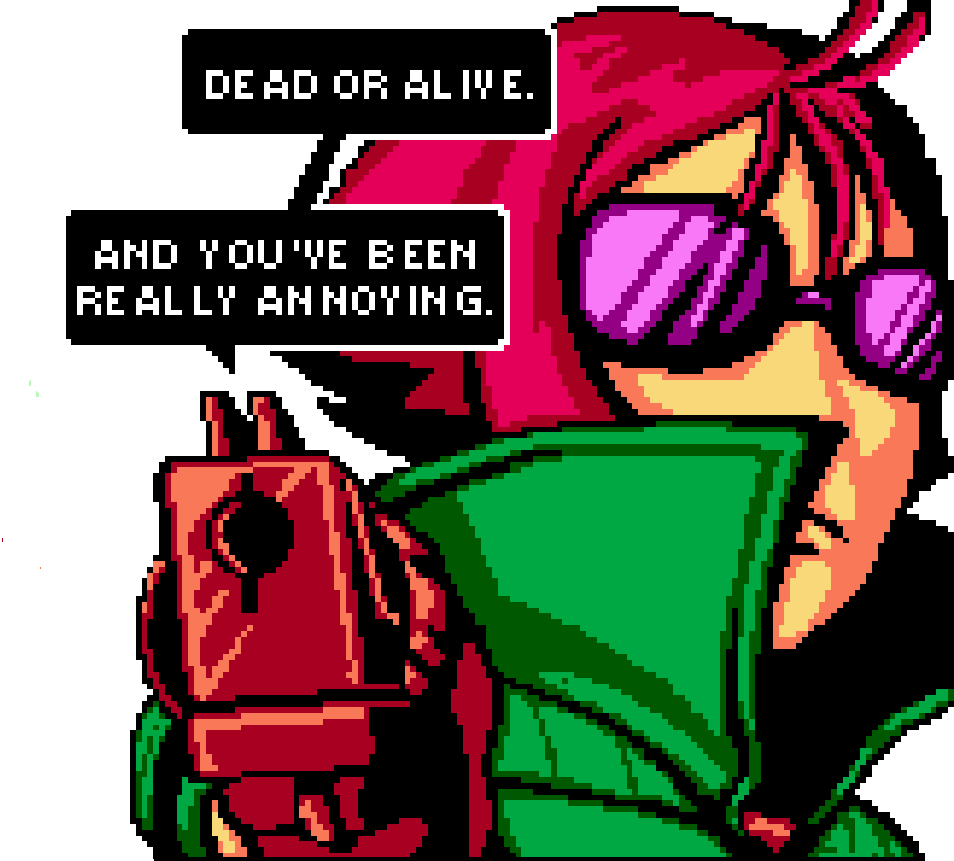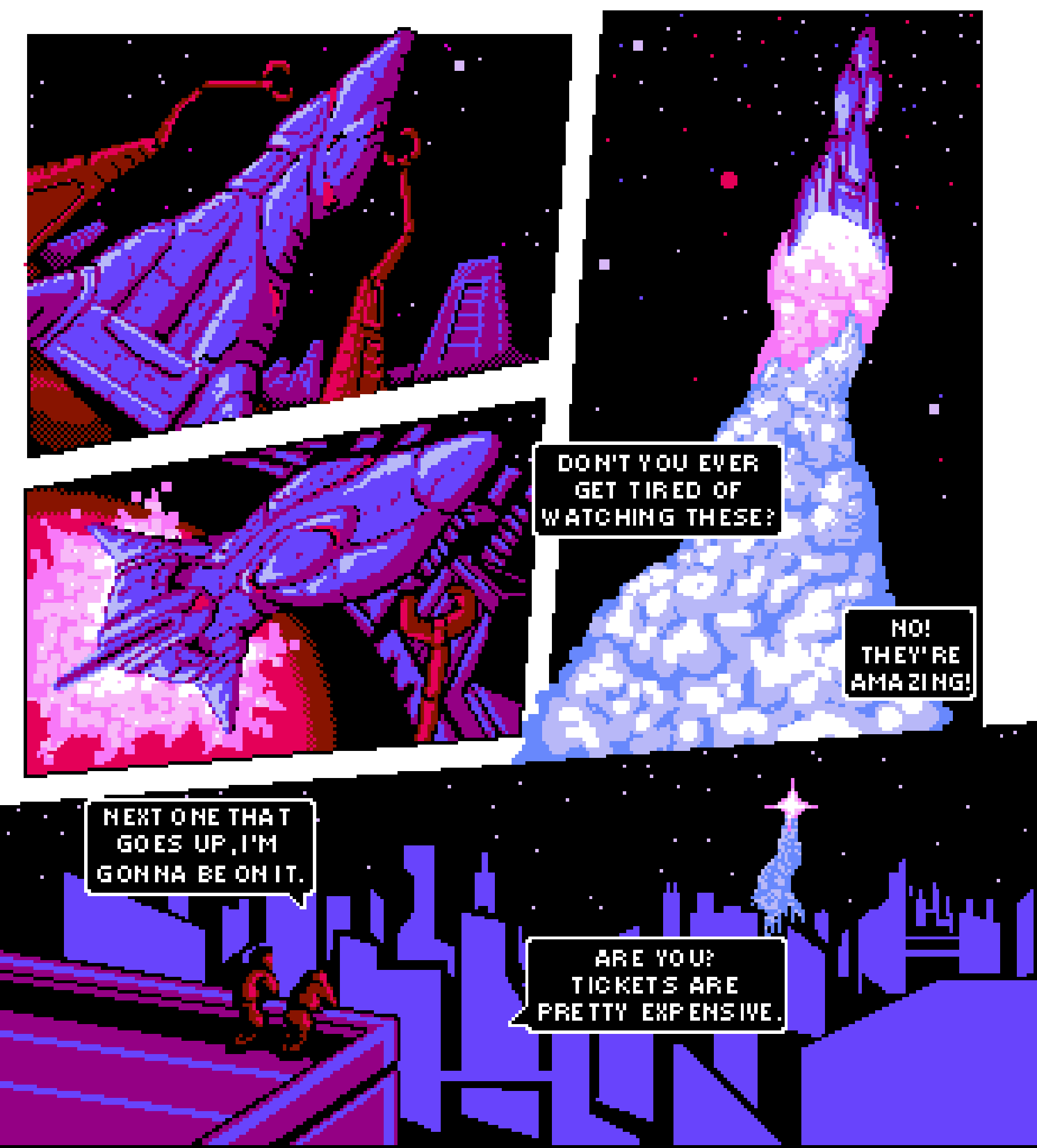Veronica Darkwater lives in a world that's a bit jagged around the edges. That's because she's the heroine of Matt Ritter and Adam Elbatimy's Nova Phase, a comic that is drawn in an 8-bit style reminiscent of old-school video games.
Robot 6 readers got a sneak peek at the first issue late last year, and now the first two issues are available on comiXology; the first issue is free, and the second is just 99 cents. Ritter and Elbatimy plan on a six-issue story to be released digitally first, with every two issues collected into a print comic by SLG Publishing. Eventually, the whole story will be collected in one print volume.
This comic raises some interesting questions of technique and format, so I asked Ritter and Elbatimy to share some of their process and their thinking.
Robot 6: I know everyone asks this, but I'm going to start with it anyway: Where did the idea for this comic come from? Why do a space opera about a bounty hunter in 8-bit-style art? Did the story come first, or was the art a part of the concept from the beginning?
Matthew Ritter: I was interning over at Dark Horse Entertainment, and I wanted to pitch them something before I left. So I contacted my artist friend Adam, who I had worked on other projects with/for. We both loved comics and pixel art, so as we tossed ideas back and forth we settled on pixel art. We talked about some video game spoof comics and other ideas, and eventually I wrote a little short piece set in the Nova Phase world, he liked it, and so we went on from that.
Adam Elbatimy: Like Matt said, we had worked together on a few pixel art related projects in the past, so I suppose when he had the opportunity to pitch something to Dark Horse, he contacted me about illustrating a comic entirely in pixel art. I was in the unique position of being interested in both comic story telling and low resolution pixel art, two life-long interests which I hadn't really ever combined in the past. The notion of doing a pixel art comic that wasn't just reusing assets from games or simple sprite placement was pretty exciting to me, and I was eager to give it a try. The art was very much the driving force behind the comic, but I think we definitely stumbled on a story that really worked within that idea. It's exactly the kind of thing an old video game would be about, but it takes itself very seriously, just like a cutscene from a video game might. I think Matt sent me the script for the pitch, and I was just like "Yeah, I can see this, it works." It was very '90s anime, and it just clicked.
How do you even do a comic in a style like this? I assume you are working digitally. Is there a setting or do you have to laboriously piece together the pixels by hand?
Elbatimy: Everything is done digitally at a very low resolution. I typically do broad sketches zoomed out, then get in close to work at the pixel level. It is a very meticulous process. Sometimes, the level of zoom I'm working at is equivalent to placing my face a quarter of an inch away from the page. I use a rather old copy of Adobe Elements, and basically just work small, with a single pixel-wide brush.
The colors are very bright, and some of the scenes have a limited palette. To what extent are color choices a part of this style — are 8-bit comics always high-chroma? What were you trying to convey with your color choices?
Elbatimy: So for this particular comic, I have limited myself to a pretty small palette, only the colors that a Nintendo Entertainment System could generate on screen, approximately. Now, actual NES games were restricted in how many of those colors it could display on screen at a time by memory and programming wizardry, but in this case I am using as many of those albeit limited colors as I see fit. Because of the limited palette, many things are colored in the nearest approximation to what they might be in real life, so you get some pretty garish and vivid designs, with red guns and purple skylines. I don't think future pixel art comics, if there are in fact any more going forward, would be limited to that particular look, but in this case I am going to great lengths to really be evocative of the artwork from that particular gaming machine.
In terms of when I use what colors, I try to tie my color choices to a vague idea of mood and theory. It's hard to put into words, but some scenes just feel a certain color.
In terms of the story, you have set up a cast of characters and a quest — everybody's after that coin. That's a very classic storyline; what makes Nova Phase different from other sci-fi stories like this?
Ritter: Nothing! Well, that's not true. But at its heart, it is just like every other story like this. The quest doesn't really matter. It's not about the quest. They want some treasure, so do the bad guys. That's every story ever, that isn't just a straight character study. It's about the journey, it's about the characters. It's about how they change or they don't along that journey. It's about Veronica Darkwater, and if she finds her selfless attitude a help or a hindrance, and at the end of the story is she reinforced in her world view or has it shifted. It's about Dillard, and his views on family, and whether or not family is a liability or necessity. It's about things like that. It's about failure, it's about reaching for the stars and missing, and it's about how all of us, every last one of us has failed at achieving our dreams, and life is about how we handle that.
It's about all those things! Also, cool pixel graphics in space. WOOOOOOOOORRRRRRRRRRRSH!
Elbatimy: There's this notion that every idea is a culmination of every idea that came before it. While technically Nova Phase is pretty similar to most works in this genre, the influences that are acting on its creation, I think, are very different. As for the art, I grew up in a very strange time, when the world was kind of opening up artistically. I was exposed to pretty diverse stuff as a kid, ranging from western superhero and newspaper comics, American science fiction/fantasy like Star Wars, Japanese video games and cartoons from all the way back to the '60s, and all of those exposures color the way I look at storytelling. Just like Lucas drew on old westerns, Kurosawa movies, and iconic cultural archetypes and myths to create something vivid and new out of otherwise familiar material. Our characters are familiar tropes, maybe, but they are deconstructed by our modern sensibilities and turned into something new. That's the idea, anyway.
Which character was your favorite to write, and which posed the most challenges?
Ritter: Probably my favorite to write, and the one that I find the hardest, is Sathal Chambers, the older gentleman. I enjoy his archetype: the heroic badass, now well past his prime. It's the danger we all face, no matter what: If life doesn't kill us, it takes away the things that made life great. You don't see it often as a serious character, generally they're in a one off story, or they're kind of just there to reflect the horrible future of the main character. I don't think this is valid. I know many people who are 'over the hill' as it were, who are far more interesting, and useful, and definitely more motivated than I am. So, being able to write about such a character is something I've enjoyed.
It's also the most challenging, as I'm still young. I'm not even thirty yet. So, I can only go off my own perceptions of what age is like. Of the people I’ve met, talked to, the stories and such I’ve read. My own grandparents and such. It'll be a long time before I'm experiencing it all first hand, and thus he might be coming off very different as I write him today than if I wrote him in say, forty years from now. His frustrations are not my frustrations. He fears that he's already done everything he's likely to do and wasted the time he had. My fears are that I'll waste the time I have left. Totally different!
Elbatimy: I didn't really write anybody, per se, but there's a visual language that comes with illustration and storytelling, and Matt has allowed me a lot of artistic freedom in terms of expression, posture, composition, etc. I try to use that freedom to reinforce what I feel is at the heart of a scene or character. This comes easier with some characters than others, though. I think Dillard is probably the most difficult, because he is this kind of distant "cool" character, the kind of character that doesn't invite empathy or kinship, whether to other characters or to the reader.
You have an interesting publishing plan, starting with digital publication via comiXology and then doing print collections of two issues each. Can you explain the details of this and why you chose to go this route? Why publish single issues in print? Will there be a collected edition so we can read the whole story in a single book?
Ritter: The setup like that is because of the publisher SLG. It's what they have been doing recently. They've had success with the two issue format with their other books, and so they offered it to me. Originally I had thought it was going to ONLY be digital, so I was overjoyed to hear there was any kind of a published release. As far as I know, yes, there is going to be a collection of the whole story in a single book once all the issues are out.
Elbatimy: I don't know the exact details, but I assume the reason for the two-issue collection format is that SLG has found that when publishing indie titles without a built-in audience, it can sometimes be difficult to convince people to pay for single individual issues. This gives them a bit more to buy in one go. As I said, I've heard they're having decent luck with it. I'm just excited to be able to hold my physical book in my hand.
I don't have a ton of insight into this, but from what I can gather, this is something SLG has done that has worked, and it suits the nature of the comic, I think. I haven't seen the art printed, (though I am very eager to), but it definitely looks right at home on a phone or computer screen; crisp, colorful, literally exactly as it was drawn, without anything lost in translation.
How many issues do you have planned? Have you finished writing the story or is it open-ended?
Ritter: Six issues. The story I'm currently writing is six issues long. It's basically finished being written, though the art is still being done, and I keep making changes all the time, and tweaking it. As for it being a totally finished story, or open-ended, that depends. You'll have to see where the story goes! Hopefully exciting dynamic interesting cool pixel arty places.
Though, even if no one reads it, I'm having a great time creating it, and that's the real point, right?
Elbatimy: I think Matt and I would both love to continue to keep doing comics, whether they be Nova Phase or something new. As for whether the story is finished or not, as Matt said, we'll just have to wait and see.





